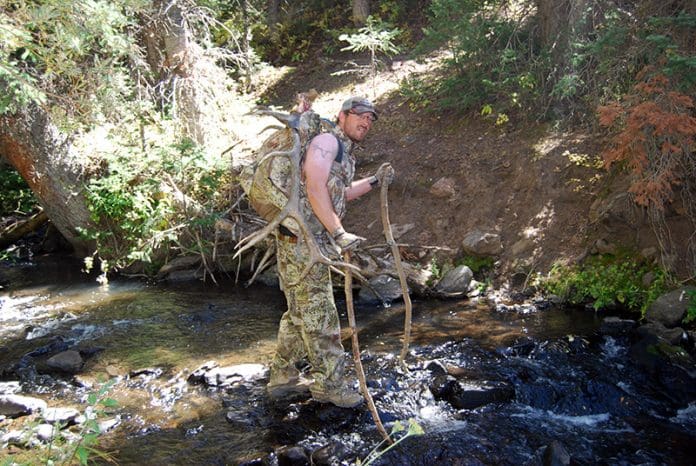The Trick-Pin System – Quit Your Range-Finder Habit
Darin Cooper – Rokslide Senior Editor
This may be the coolest damn thing you never knew about your bow!
We have all heard somebody say something ridiculous like, “This new bow is so fast you probably only need one pin out to 50 yards!” And to that, experienced bowhunters can collectively answer, “Right dude… Good luck with that!” That is… until I let you all in on one of my best kept secrets. By the way, bowhunters using single-pin, movable-sights – this is THE WAY to set your sight up for hunting.
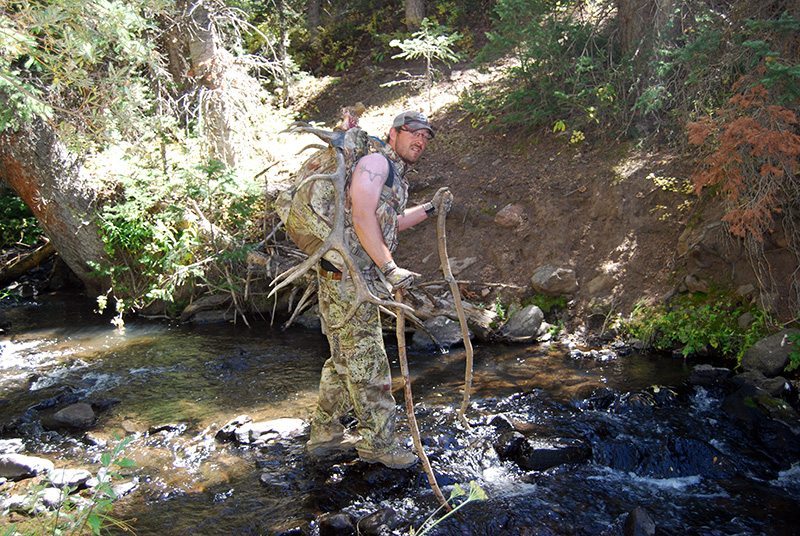
This UT Bull got tricked!
Don’t get me wrong, there are a lot of high performance bows available today, but bows have pretty much arrived at the peak of their performance potential unless some seriously new technology is developed. To illustrate the point in my intro, let’s assume I wanted to shoot a super-fast bow that cranks a hunting arrow out at 330 fps. I would still completely miss the vitals on a broadside mule deer at 30 and 46 yards if I aimed dead-on with my 40-yard pin*. That’s assuming a huge, 10-inch (+/- 5”) vital zone. In other words, this fast bow example is still a long way from effectively using one pin out to 50 yards.*(Based on calculations from Archer’s Advantage software)
Now just imagine if you could hit the vitals every time shooting a single pin between 15 and 40+ yards. No rangefinder and no speed bow required, just one sight pin and you always aim at the same place.
There is a secret that’s been handed down through the annals of professional archery and I’m going to share it with Roksliders. Remember, this is top secret stuff so don’t go sharing it with everybody you know – just good friends and hunting partners!
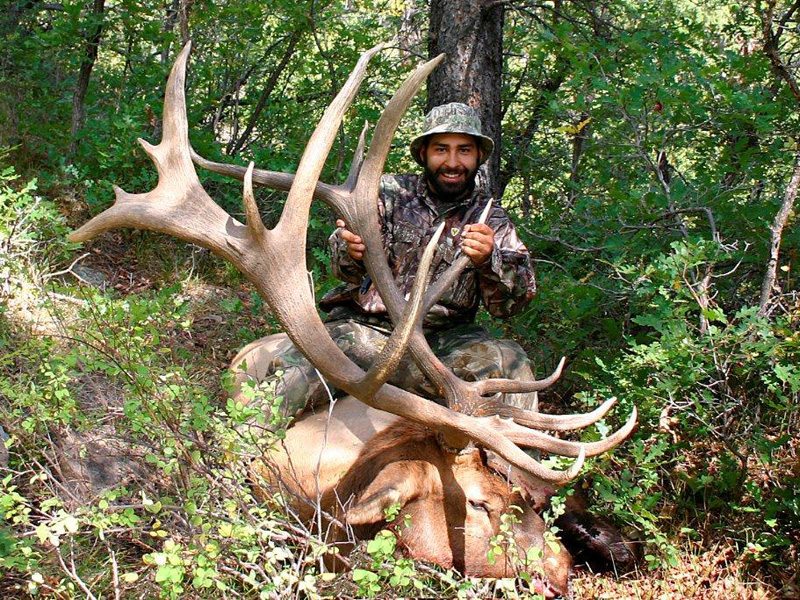
I shared the secret with my good friend Dan’l Anselmo and he used the trick-pin system to harvest this outstanding archery bull.
The reason the trick pin works is because we are taking advantage of the flattest part of the arrow’s trajectory. This occurs in the middle of the arrow’s flight path near its peak, not at the sight in distance where the arrow is only dropping (see the red dotted arrow path in the figure below). In order to utilize this flat-shooting part of the trajectory, we have to aim about a foot low using a longer range sight pin. In this example you can see that the down-range zero occurs at 52 yards where the red dotted line crosses 0″ in height on the right side of the graph. That’s the pin’s sight-in distance. The trajectory of the arrow shot from this setup with the 52-yard pin peaks at 15-inches high at 26 yards.
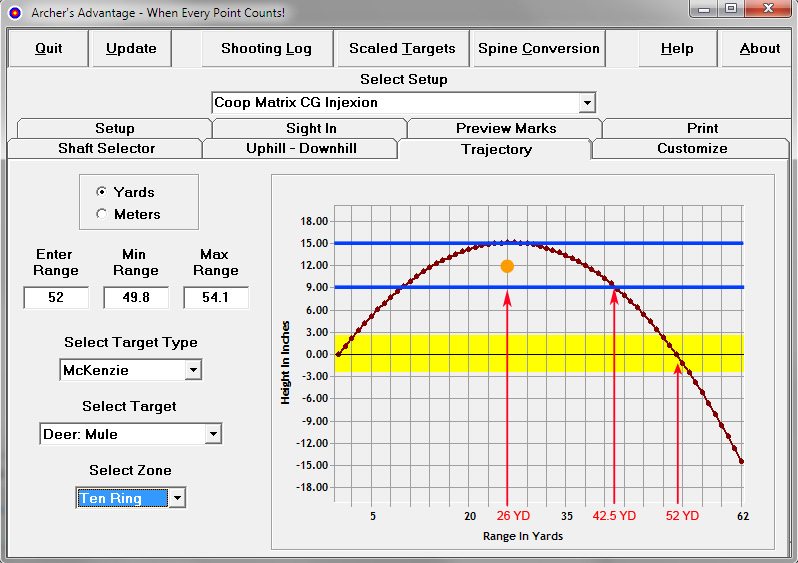
Archer’s Advantage can be used to model your trajectory. The program accurately predicts the limit of the “Trick Pin” for my test bow at the point where the trajectory line crosses the lower blue line on the right at 42.5 yards. The yellow area represents the size of a McKenzie 3D mule deer target 10-ring. Note – it’s approximately the same size as the 6-inch window shown in blue.
The arrow stays inside the 6-inch window bounded by the blue lines, between 9 & 15 inches high, for any shot taken between about 10 and 42.5 yards away from the target. The orange dot is positioned at the center of the “window” at 12 inches above the aim point. The dot is there to represent the center of the vitals we are trying to hit.
This seems a little complex at first glance, but in reality, the hardest part about using this technique is that you have to be able to judge 12-inches. In my opinion, that’s a lot easier than judging 33 or 41 yards with the bull of a lifetime cranked up and tearing the forest a new one as you try not to crap yourself.
If the explanation is a little hard to follow, don’t worry! You don’t need Archer’s Advantage, a trajectory model, or a master’s degree in physics to figure out and use the trick-pin. It’s actually really simple to make a special target to guide you through properly setting up and testing your very own custom “trick-pin” – Here’s how you do it:
1. Get a piece of cardboard or poster-board about 24”h x 12”w and spray paint it black or white for better contrast so it’s easy to see and aim at.
2. Lay down a perfectly vertical strip of masking tape or electrical tape from top to bottom down the center of the cardboard. Use a tape color that contrasts with the color of your cardboard background so it will be easiest to see.
3. Next, place a 6” horizontal strip of tape to make a cross-hair (+) eight inches below the top of the cardboard (shown in orange). Then, use a tape measure and place two more 6” horizontal strips so the centerlines are exactly 3” above and 3” below the first strip (shown in blue).
4. Now paint or stick on a bull’s-eye over the center cross-hair.
5. Finally, place the last horizontal strip exactly 12” below the bull’s-eye. When you’re finished, your target should look like this.
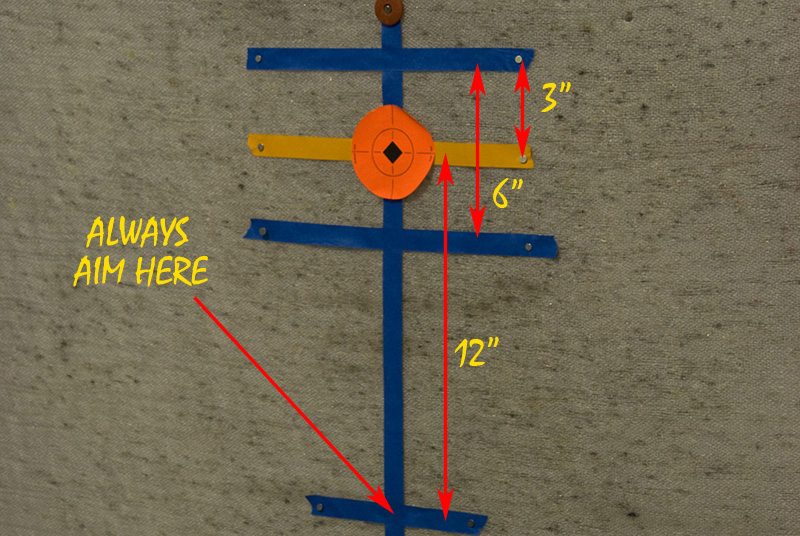
I laid out this test target directly on a target bale. Set yours up on a cardboard sheet to make it portable, reusable, and more durable as shown in later photos.
Next we are going to shoot at the test target to help us determine exactly what distance we need to set our “Trick Pin” for. I want you to start by using the trick-pin sight in distance recommended for your arrow’s velocity range in Step 6. This is a good starting point but will most likely require some fine tuning to get it dialed in perfectly.
6. Decide where to set your “Trick Pin” based on the appropriate velocity range below:
- If your arrow velocity is in the 250 – 290 fps range, use your 50-yard pin as your trick pin.
- If your arrow velocity is 290 – 320+ fps aim with your 55-yard pin gap for the trick pin.
- If you are shooting 200-250 fps you should start by aiming with your 45-yard pin gap as your trick pin.
- If you are shooting slower than 200 fps aim with your 40-yard pin.
7. Next, back up from the target to ½ the distance of the pin you’re using. For example, shoot from 25 yards if you’re using your 50-yard pin. This half-way point should coincide with the top of your arrow’s trajectory. Therefore, shooting from this distance will reveal the highest point your arrow can hit on its way to the target. *Remember, you are ALWAYS going to aim with the trick pin at the BOTTOM strip of tape (12” below the bull’s eye).
7. Shoot a few arrows aiming at the bottom strip of tape using the trick pin. Concentrate to make sure your elevation is good when making these shots. Left and right errors are not important.
9. If you’ve done everything correctly, your arrows should be impacting pretty close to the top horizontal strip of tape, three inches above the bull’s-eye. If you’re off, adjust the trick pin in the same direction you missed the upper tape line.
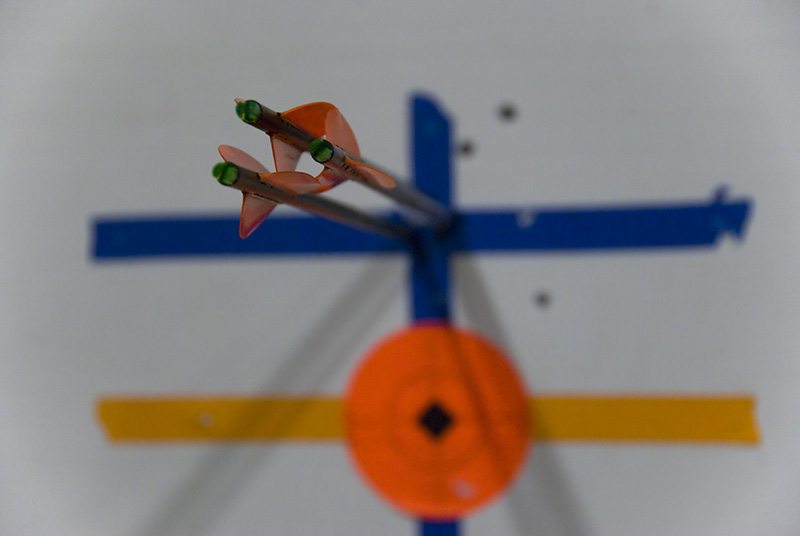
This group was shot at 26 yards while aiming at the bottom line with my trick-pin sighted in at 52 yards. The trajectory model shows that for distances greater than AND less than 26 yards the arrows will hit lower than this group. So, this is the most I can miss the target high using the trick pin.
- Important: If you move the sight pin to adjust your group height, you also need to change your shooting position so that you stay approximately half the distance of the pin’s new sight in distance. If you have moved the pin to about 46 yards, you need to shoot the next shots from 23 yards. If you moved the pin to 52 yards, shoot from 26 yards. Keep adjusting and moving until your group is centered on the upper line.
10. Once you get your trick-pin dialed in, walk back and forth and shoot with the trick pin between about 10 and 45+ yards and figure out where the limits of your setup are. The goal is to figure out how far away you can shoot and still keep all of your arrows between the upper and lower strips of tape surrounding the bull’s-eye. That six-inch window is your miss tolerance and represents the vital area of the animal you’re going to hunt.
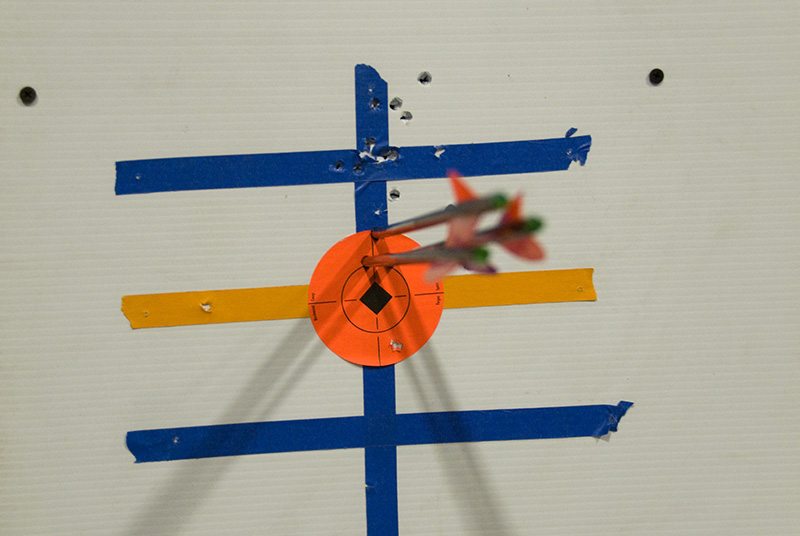
Another trick-pin group shot from 35 yards
I like to limit my “misses” to a maximum of +/- three inches. This is why I set the tape strips 3” above and below the bull’s-eye. After testing the limits I found that I have to compensate for elevation when I’m beyond about 42.5 yards with this hunting setup.
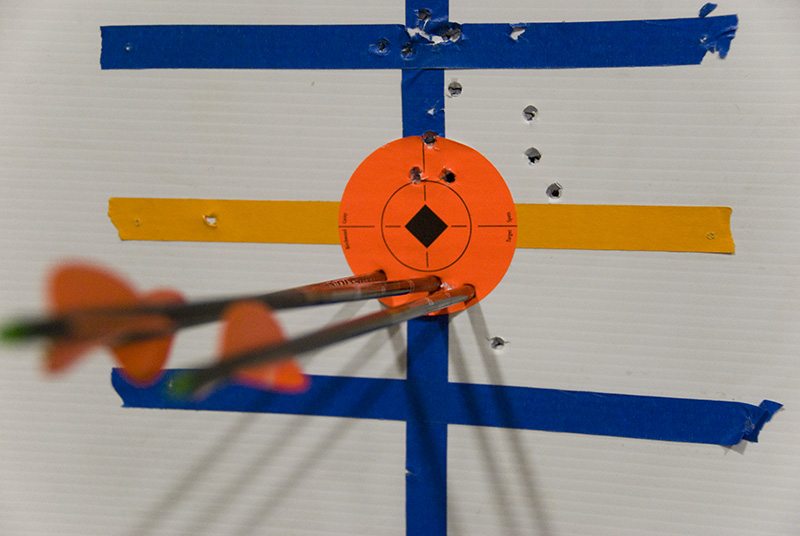
40-yard group
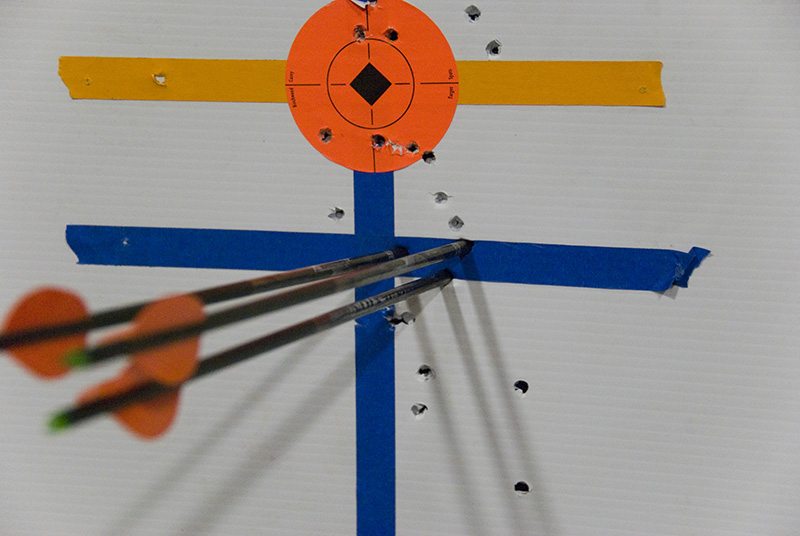
A group from 42.5 yards illustrates the outer limit for this setup with a six inch “vital” window or miss-tolerance.
Your results will definitely vary depending on the speed you’re shooting. A hunting speed of 320 fps may allow you to use the trick pin all the way out to 47 yards, while a 200 fps bow may only work to 35 yards.
If you’re hunting antelope your error tolerance may need to be smaller since an antelope’s vitals are going to be smaller. No problem, just make the tape window 2” above and below the bull’s-eye and re-test. This will reduce the range you can use the trick pin, but it still works the same way.
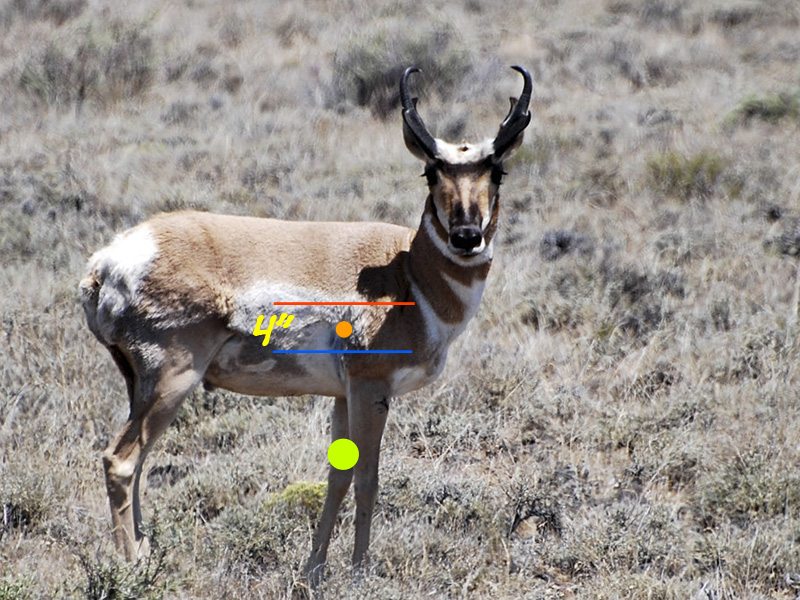
Antelope bucks will typically have a chest cavity that measures 12-14 inches
Conversely if you’re comfortable with vital window of +/- 4” on elk, just make the tape window larger and all the same setup principles apply. With a speed bow and trick-pin set up properly for elk hunting you can stretch the effective window to 50 yards. Opening the window to +/- 4″ extends the maximum trick pin range to 45.5 yards for my test setup. If you want to be sure you don’t shoot too high, you can also make the window asymmetric and set the upper limit at +2″ and the lower at -3″ or -4″. The point is – the system is flexible, so get custom with it.
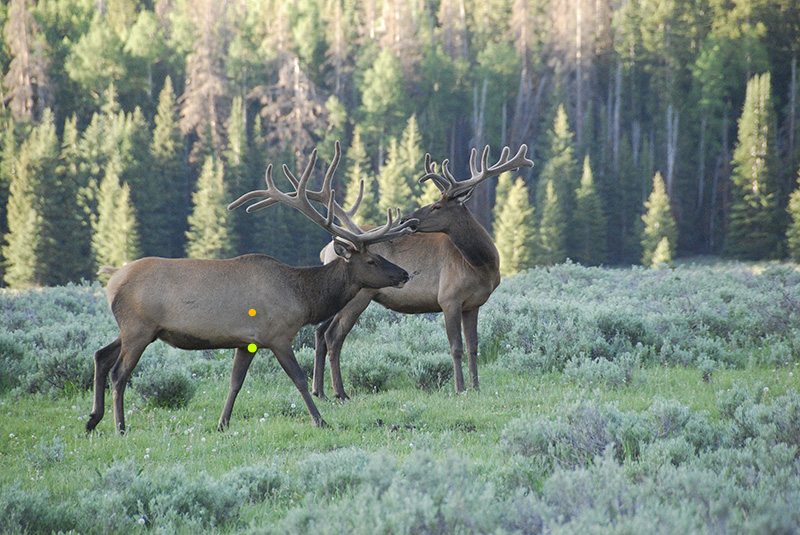
The chest of a mature bull typically measures 28 – 30 inches
The obvious limitation to using this system in a hunting situation is that you have to figure out how to aim 12” below the center of the vitals so you can make a fatal shot. With that in mind, you have to realize we’re not trying to thread the needle – we’re merely trying to hit the center of the lungs. The best way that I’ve found to train my mind is to use a tennis ball on a string with 3D targets. Cut a slit in the tennis ball with a utility knife and tie a knot on the end of piece of parachute cord. Shove the knot into the tennis ball and then hang the string from a nail 12” below the spot you want to hit. Do this from multiple angles and use the same type of 3D animal that you plan to hunt. Pretty soon you’ll get a really good feel for where to aim and it will become second nature.
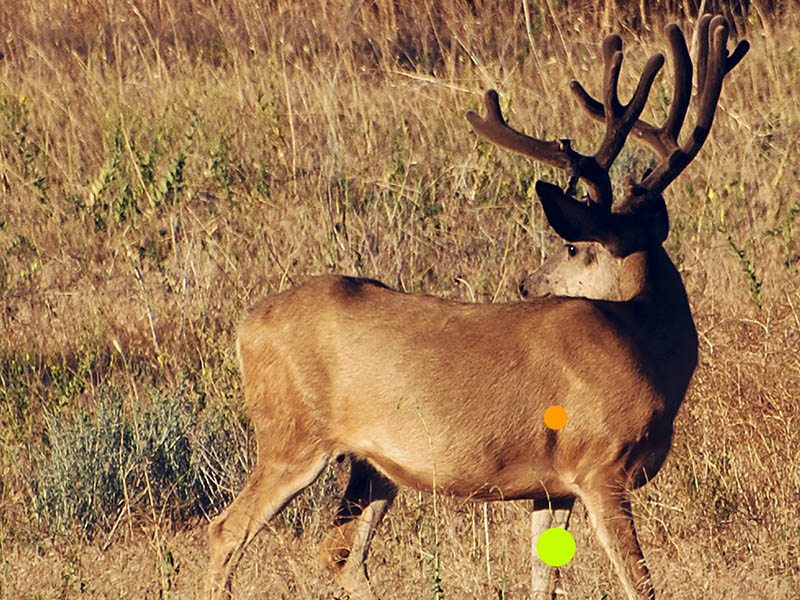
A mature muley buck has a chest cavity that measures about 18″ high
This is a really effective way to improve your chance of a fatal shot on animals that are relatively close because it allows you to speed up the shot process and eliminates all of the extra movement that using a rangefinder would require.
On a mature bull elk, it’s pretty easy to pick a spot – aim at the bottom edge of the chest directly below the vitals and you’ll impact 12” up if you’re within your trick pin range – that should put your arrow right in the center of the boiler room +/- a couple inches.
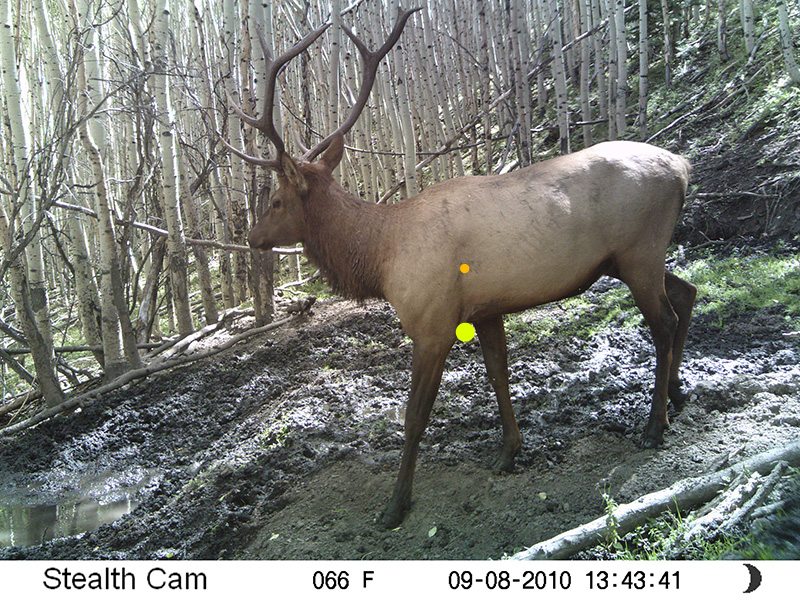
For cows and smaller bulls, hold a couple inches under the hairline
Elk hunting in particular really lends itself well to using the technique because of their built in aiming point and the fact that the majority of elk shots occur within range of the trick pin system. Elk can be pretty unpredictable – sometimes they come in silently and in a totally different spot than you expect them, and other times they’re blowing your hat off and stampeding over the top of you. In close range situations like this you’ll have a big advantage if you can forget about the range and focus on making the shot.
One thing that’s nice about the trick pin system is that you can customize it however works best for you. I use a 12-inch hold under because a foot is pretty easy to judge and it works out that most of my hunting setups have about 15” of trajectory at 50 yards. This allows me to use my 50 yard pin and fits my +/- 3” window. Now if 12” doesn’t work for you, then experiment and aim 8, 10, or 14 inches low with your trick-pin until you find a combination of sight-in distance and hold-under that works best for your setup and the specie you’re after. Don’t be afraid to experiment with the marks on the test target to help you dial in the necessary hold-under and vital window. Just be sure to test the full range for your setup when you finish so you can verify it works and so you can document the new limits for your configuration.
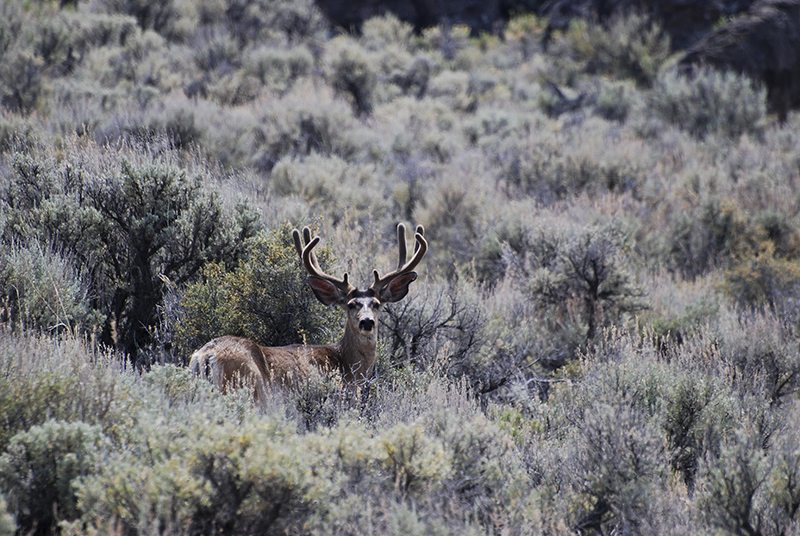
Here’s a shot that doesn’t lend itself well to the trick pin
Most mule deer shots for me happen at longer distances, but with a trick pin, you’ve got the short range shots covered and you could theoretically shoot 20 – 80 with a 5-pin sight by setting a 20 yard pin, a trick pin at “50-ish”, and pins at 60, 70, and 80 yards.
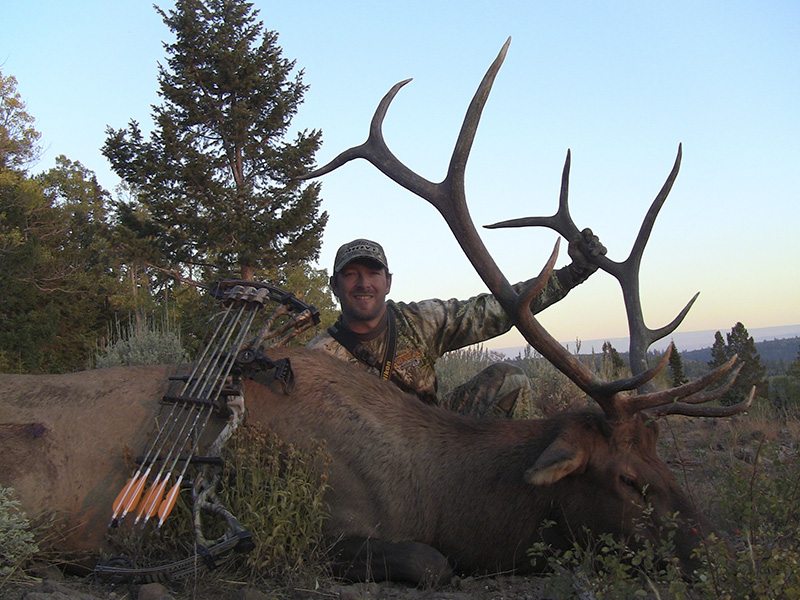
Author’s 2010 Utah Bull taken at close range using his “trick-pin” system
It’s not a cure-all, never-miss tactic, and it does require practice and a little time to set it up – but for archers using single-pin bowsights and for elk hunters it can really simplify things at the moment of truth. With the trick pin up your sleeve you’ll be prepared to tackle the unexpected and you’ll be more efficient in pressure-packed, close-range encounters. Be sure to let me know if this trick helps you punch your tag next season! If you have questions or comments regarding the article meet me here in the forum to discuss!
Shoot straight!














